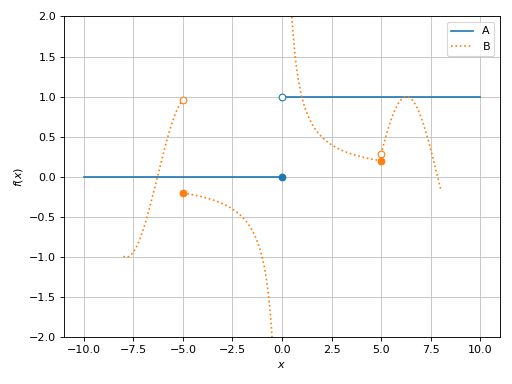2D general plotting
NOTE:
For technical reasons, all interactive-widgets plots in this documentation
are created using Holoviz’s Panel. Often, they will ran just fine with
ipywidgets too. However, if a specific example uses the param library,
or widgets from the panel module, then users will have to modify the
params dictionary in order to make it work with ipywidgets.
Refer to Interactive module for more information.
- spb.plot_functions.functions_2d.plot(*args, **kwargs)[source]
Plots a function of a single variable as a curve.
Typical usage examples are in the followings:
Plotting a single expression with the default range:
plot(expr, **kwargs)
Plotting a single expression with a custom range, custom label and rendering options.
plot(expr, range, label [opt], rendering_kw [opt], **kwargs)
Plotting multiple expressions with a single range.
plot(expr1, expr2, ..., range, **kwargs)
Plotting multiple expressions with different ranges, custom labels and rendering options.
plot( (expr1, range1, label1 [opt], rendering_kw1 [opt]), (expr2, range2, label2 [opt], rendering_kw2 [opt]), ..., **kwargs)
Refer to
line()for a full list of keyword arguments to customize the appearances of lines.Refer to
graphics()for a full list of keyword arguments to customize the appearances of the figure (title, axis labels, …).- Parameters:
- labelstr or list/tuple, optional
The label to be shown in the legend. If not provided, the string representation of expr will be used. The number of labels must be equal to the number of expressions.
- rendering_kwdict or list of dicts, optional
A dictionary of keywords/values which is passed to the backend’s function to customize the appearance of lines. Refer to the plotting library (backend) manual for more informations. If a list of dictionaries is provided, the number of dictionaries must be equal to the number of expressions.
See also
Examples
>>> from sympy import symbols, sin, pi, tan, exp, cos, log, floor >>> from spb import plot >>> x, y = symbols('x, y')
Single Plot
>>> plot(x**2, (x, -5, 5)) Plot object containing: [0]: cartesian line: x**2 for x over (-5.0, 5.0)
(
Source code,png)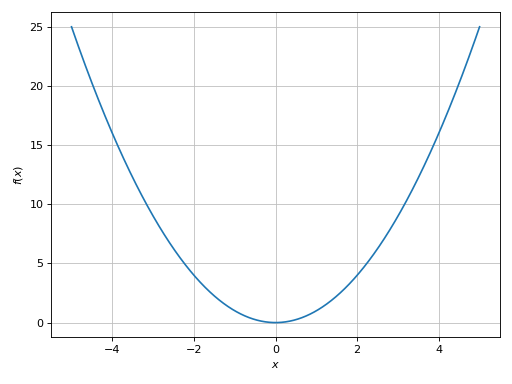
Multiple functions over the same range with custom rendering options:
>>> plot(x, log(x), exp(x), (x, -3, 3), aspect="equal", ylim=(-3, 3), ... rendering_kw=[{}, {"linestyle": "--"}, {"linestyle": ":"}]) Plot object containing: [0]: cartesian line: x for x over (-3.0, 3.0) [1]: cartesian line: log(x) for x over (-3.0, 3.0) [2]: cartesian line: exp(x) for x over (-3.0, 3.0)
(
Source code,png)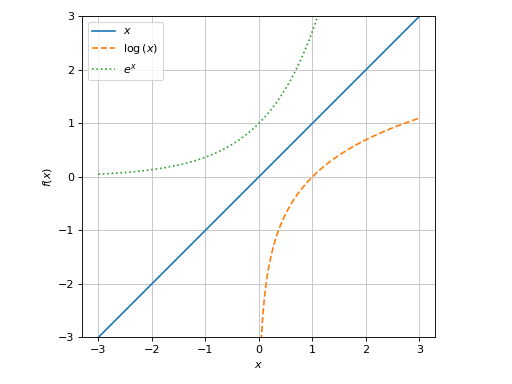
Plotting a summation in which the free symbol of the expression is not used in the lower/upper bounds:
>>> from sympy import Sum, oo, latex >>> expr = Sum(1 / x ** y, (x, 1, oo)) >>> plot(expr, (y, 2, 10), sum_bound=1e03, title="$%s$" % latex(expr)) Plot object containing: [0]: cartesian line: Sum(x**(-y), (x, 1, 1000)) for y over (2.0, 10.0)
(
Source code,png)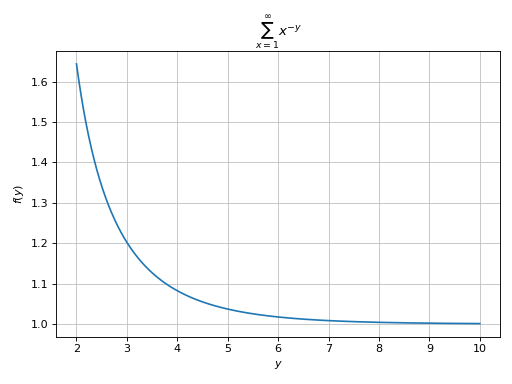
Plotting a summation in which the free symbol of the expression is used in the lower/upper bounds. Here, the discretization variable must assume integer values:
>>> expr = Sum(1 / x, (x, 1, y)) >>> plot(expr, (y, 2, 10), adaptive=False, ... scatter=True, is_filled=True, title="$%s$" % latex(expr)) Plot object containing: [0]: cartesian line: Sum(1/x, (x, 1, y)) for y over (2.0, 10.0)
(
Source code,png)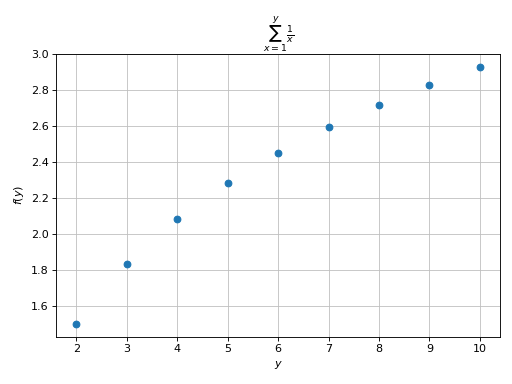
Using an adaptive algorithm, detect and plot vertical lines at singularities. Also, apply a transformation function to the discretized domain in order to convert radians to degrees:
>>> import numpy as np >>> plot(tan(x), (x, -1.5*pi, 1.5*pi), ... adaptive=True, adaptive_goal=0.001, ... detect_poles="symbolic", tx=np.rad2deg, ylim=(-7, 7), ... xlabel="x [deg]", grid=False) Plot object containing: [0]: cartesian line: tan(x) for x over (-4.71238898038469, 4.71238898038469)
(
Source code,png)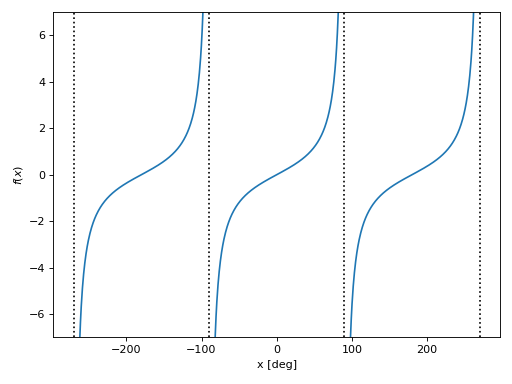
Introducing discontinuities by excluding specified points:
>>> plot(floor(x) / x, (x, -3.25, 3.25), ylim=(-1, 5), ... exclude=list(range(-4, 5))) Plot object containing: [0]: cartesian line: floor(x)/x for x over (-3.25, 3.25)
(
Source code,png)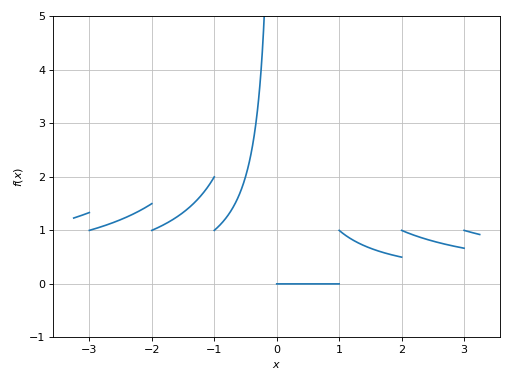
Advanced example showing:
detect singularities by setting
adaptive=False(better performance), increasing the number of discretization points (in order to have ‘vertical’ segments on the lines) and reducing the threshold for the singularity-detection algorithm.application of color function.
>>> import numpy as np >>> expr = 1 / cos(10 * x) + 5 * sin(x) >>> def cf(x, y): ... # map a colormap to the distance from the origin ... d = np.sqrt(x**2 + y**2) ... # visibility of the plot is limited: ylim=(-10, 10). However, ... # some of the y-values computed by the function are much higher ... # (or lower). Filter them out in order to have the entire ... # colormap spectrum visible in the plot. ... offset = 12 # 12 > 10 (safety margin) ... d[(y > offset) | (y < -offset)] = 0 ... return d >>> p1 = plot(expr, (x, -5, 5), ... "distance from (0, 0)", {"cmap": "plasma"}, ... ylim=(-10, 10), adaptive=False, detect_poles=True, n=3e04, ... eps=1e-04, color_func=cf, title="$%s$" % latex(expr))
(
Source code,png)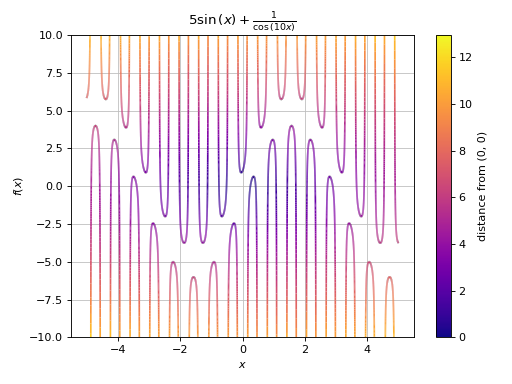
Combining multiple plots together:
>>> p2 = plot(5 * sin(x), (x, -5, 5), {"linestyle": "--"}, show=False) >>> (p1 + p2).show()
(
Source code,png)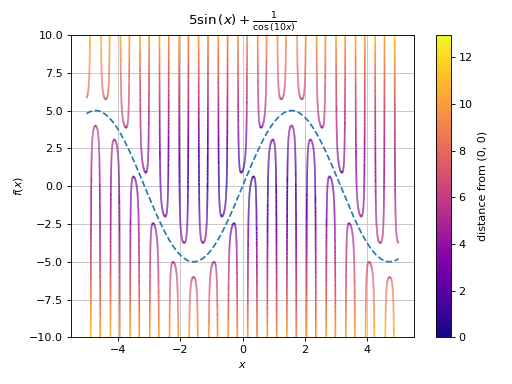
Plotting a numerical function instead of a symbolic expression:
>>> import numpy as np >>> plot(lambda t: np.cos(np.exp(-t)), ("t", -pi, 0))
(
Source code,png)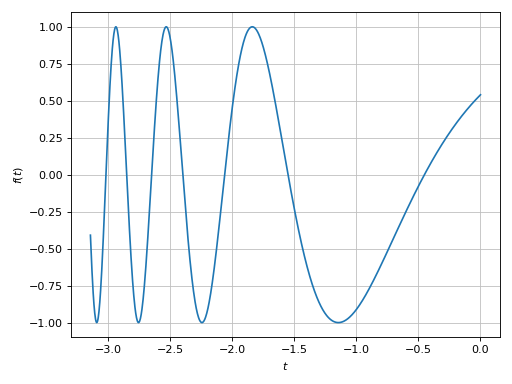
Interactive-widget plot of an oscillator. Refer to the interactive sub-module documentation to learn more about the
paramsdictionary. This plot illustrates:plotting multiple expressions, each one with its own label and rendering options.
the use of
prange(parametric plotting range).the use of the
paramsdictionary to specify sliders in their basic form: (default, min, max).the use of
panel.widgets.slider.RangeSlider, which is a 2-values widget. In this case it is used to enforce the condition f1 < f2.the use of a parametric title, specified with a tuple of the form:
(title_str, param_symbol1, ...), where:title_strmust be a formatted string, for example:"test = {:.2f}".param_symbol1, ...must be a symbol or a symbolic expression whose free symbols are contained in theparamsdictionary.
from sympy import * from spb import * import panel as pn x, y, f1, f2, d, n = symbols("x, y, f_1, f_2, d, n") plot( (cos(f1 * x) * exp(-d * x), "oscillator 1"), (cos(f2 * x) * exp(-d * x), "oscillator 2"), (exp(-d * x), "upper limit", {"linestyle": ":"}), (-exp(-d * x), "lower limit", {"linestyle": ":"}), prange(x, 0, n * pi), params={ (f1, f2): pn.widgets.RangeSlider(value=(1, 2), start=0, end=10, step=0.1), # frequency d: (0.25, 0, 1), # damping n: (2, 0, 4) # multiple of pi }, ylim=(-1.25, 1.25), title=("$f_1$ = {:.2f} Hz", f1), )
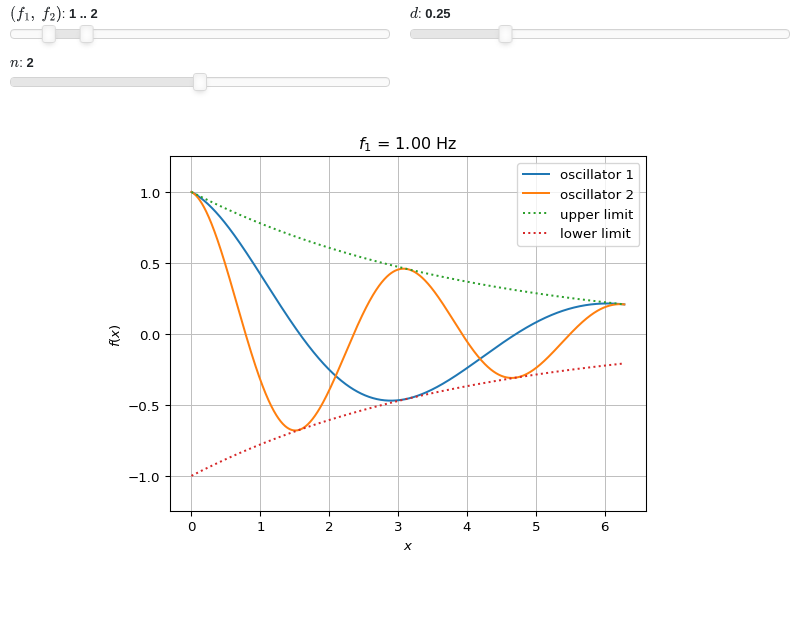
- spb.plot_functions.functions_2d.plot_implicit(*args, **kwargs)[source]
Plot implicit equations / inequalities.
plot_implicit, by default, generates a contour using a mesh grid of fixednumber of points. The greater the number of points, the better the results, but also the greater the memory used. By settingadaptive=True, interval arithmetic will be used to plot functions. If the expression cannot be plotted using interval arithmetic, it defaults to generating a contour using a mesh grid. With interval arithmetic, the line width can become very small; in those cases, it is better to use the mesh grid approach.Typical usage examples are in the following:
Plot a single expression:
plot_implicit(expr, range_x, range_y)
Plot multiple expressions over the same ranges:
plot_implicit(expr1, expr2, range_x, range_y)
Plot multiple expressions over different ranges:
plot_implicit( (expr1, range_x1, range_y1, label1 [opt]), (expr2, range_x2, range_y2, label2 [opt]))
Refer to
implicit_2d()for a full list of keyword arguments to customize the appearances of lines and regions.Refer to
graphics()for a full list of keyword arguments to customize the appearances of the figure (title, axis labels, …).- Parameters:
- labelstr or list/tuple, optional
The label to be shown in the legend. If not provided, the string representation of expr will be used. The number of labels must be equal to the number of expressions.
See also
Examples
Plot expressions:
>>> from sympy import symbols, Ne, Eq, And, sin, cos, pi, log, latex >>> from spb import plot_implicit >>> x, y = symbols('x y')
Providing only the symbol for the horizontal axis:
>>> p = plot_implicit(x - 1, x)
(
Source code,png)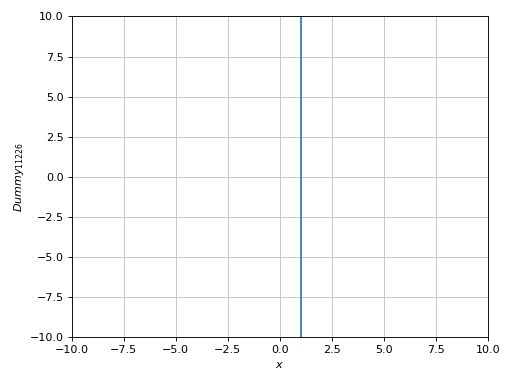
Specify both ranges, set the number of discretization points and plot a region:
>>> plot_implicit(y > x**2, (x, -5, 5), (y, -10, 10), n=150, grid=False) Plot object containing: [0]: Implicit expression: y > x**2 for x over (-5.0, 5.0) and y over (-10.0, 10.0)
(
Source code,png)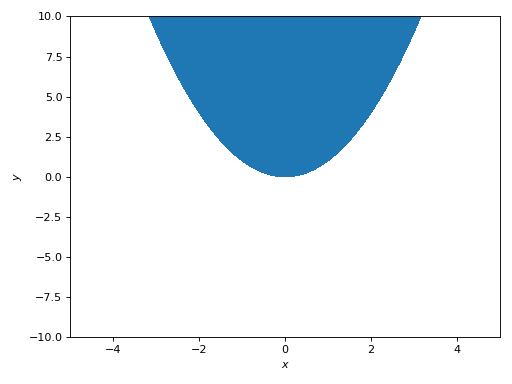
Plot a region using a custom color, highlights the limiting border and customize its appearance. In this particular case, the content of
rendering_kwwill be sent to matplotlib’scontourofcontourfcommands.>>> expr = 4 * (cos(x) - sin(y) / 5)**2 + 4 * (-cos(x) / 5 + sin(y))**2 >>> plot_implicit(expr <= pi, (x, -pi, pi), (y, -pi, pi), ... grid=False, color="gold", border_color="k", ... rendering_kw={"linestyles": "-.", "linewidths": 1}) Plot object containing: [0]: Implicit expression: 4*(-sin(y)/5 + cos(x))**2 + 4*(sin(y) - cos(x)/5)**2 <= pi for x over (-3.141592653589793, 3.141592653589793) and y over (-3.141592653589793, 3.141592653589793) [1]: Implicit expression: Eq(-4*(-sin(y)/5 + cos(x))**2 - 4*(sin(y) - cos(x)/5)**2 + pi, 0) for x over (-3.141592653589793, 3.141592653589793) and y over (-3.141592653589793, 3.141592653589793)
(
Source code,png)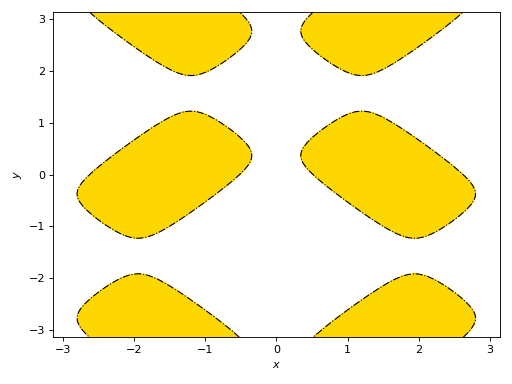
Boolean expressions will be plotted with the adaptive algorithm. Note the thin width of lines:
>>> plot_implicit( ... Eq(y, sin(x)) & (y > 0), ... Eq(y, sin(x)) & (y < 0), ... (x, -2 * pi, 2 * pi), (y, -4, 4)) Plot object containing: [0]: Implicit expression: (y > 0) & Eq(y, sin(x)) for x over (-6.283185307179586, 6.283185307179586) and y over (-4.0, 4.0) [1]: Implicit expression: (y < 0) & Eq(y, sin(x)) for x over (-6.283185307179586, 6.283185307179586) and y over (-4.0, 4.0)
(
Source code,png)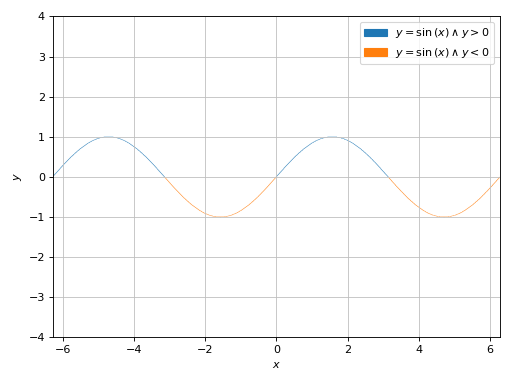
Plotting multiple implicit expressions and setting labels:
>>> V, t, b, L = symbols("V, t, b, L") >>> L_array = [5, 10, 15, 20, 25] >>> b_val = 0.0032 >>> expr = b * V * 0.277 * t - b * L - log(1 + b * V * 0.277 * t) >>> expr_list = [expr.subs({b: b_val, L: L_val}) for L_val in L_array] >>> labels = ["L = %s" % L_val for L_val in L_array] >>> plot_implicit(*expr_list, (t, 0, 3), (V, 0, 1000), label=labels) Plot object containing: [0]: Implicit expression: Eq(0.0008864*V*t - log(0.0008864*V*t + 1) - 0.016, 0) for t over (0.0, 3.0) and V over (0.0, 1000.0) [1]: Implicit expression: Eq(0.0008864*V*t - log(0.0008864*V*t + 1) - 0.032, 0) for t over (0.0, 3.0) and V over (0.0, 1000.0) [2]: Implicit expression: Eq(0.0008864*V*t - log(0.0008864*V*t + 1) - 0.048, 0) for t over (0.0, 3.0) and V over (0.0, 1000.0) [3]: Implicit expression: Eq(0.0008864*V*t - log(0.0008864*V*t + 1) - 0.064, 0) for t over (0.0, 3.0) and V over (0.0, 1000.0) [4]: Implicit expression: Eq(0.0008864*V*t - log(0.0008864*V*t + 1) - 0.08, 0) for t over (0.0, 3.0) and V over (0.0, 1000.0)
(
Source code,png)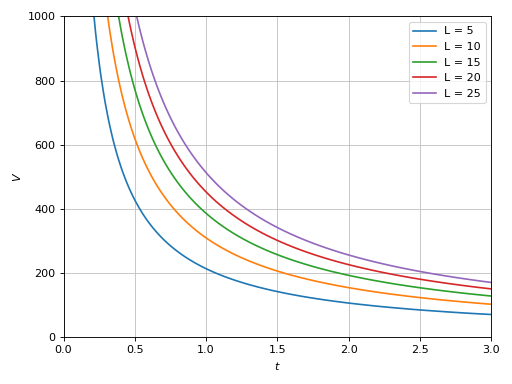
Comparison of similar expressions plotted with different algorithms. Note:
Adaptive algorithm (
adaptive=True) can be used with any expression, but it usually creates lines with variable thickness. Thedepthkeyword argument can be used to improve the accuracy, but reduces line thickness even further.Mesh grid algorithm (
adaptive=False) creates lines with constant thickness.
>>> expr1 = Eq(x * y - 20, 15 * y) >>> expr2 = Eq((x - 3) * y - 20, 15 * y) >>> expr3 = Eq((x - 6) * y - 20, 15 * y) >>> ranges = (x, 15, 30), (y, 0, 50) >>> p1 = plot_implicit(expr1, *ranges, adaptive=True, depth=0, ... label="adaptive=True, depth=0", grid=False, show=False) >>> p2 = plot_implicit(expr2, *ranges, adaptive=True, depth=1, ... label="adaptive=True, depth=1", grid=False, show=False) >>> p3 = plot_implicit(expr3, *ranges, adaptive=False, ... label="adaptive=False", grid=False, show=False) >>> (p1 + p2 + p3).show()
(
Source code,png)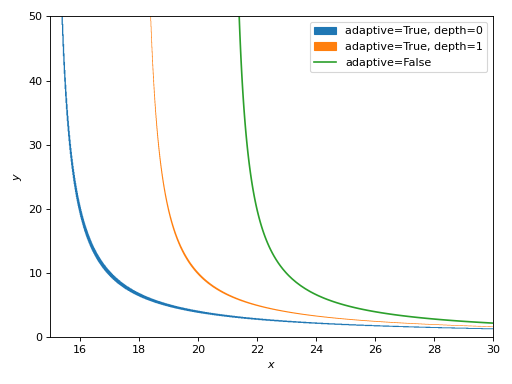
If the expression is plotted with the adaptive algorithm and it produces “low-quality” results, maybe it’s possible to rewrite it in order to use the mesh grid approach (contours). For example:
>>> from spb import plotgrid >>> expr = Ne(x*y, 1) >>> p1 = plot_implicit( ... expr, (x, -10, 10), (y, -10, 10), ... grid=False, aspect="equal", show=False, ... title="$%s$ : First approach" % latex(expr)) >>> # plot the entire visible region >>> p2 = plot_implicit( ... x < 20, (x, -10, 10), (y, -10, 10), ... show=False, grid=False, aspect="equal", ... title="$%s$ : Second approach" % latex(expr)) >>> # plot the excluded contour >>> p3 = plot_implicit( ... Eq(*expr.args), (x, -10, 10), (y, -10, 10), ... color="w", show_in_legend=False, show=False) >>> plotgrid(p1, (p2 + p3), nc=2)
(
Source code,png)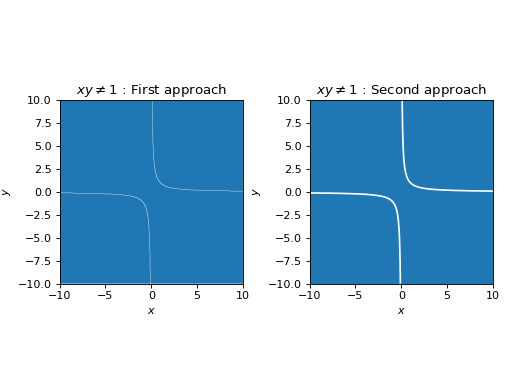
Interactive-widget implicit plot. Refer to the interactive sub-module documentation to learn more about the
paramsdictionary. This plot illustrates:the use of
prange(parametric plotting range).the use of the
paramsdictionary to specify sliders in their basic form: (default, min, max).the use of
panel.widgets.slider.RangeSlider, which is a 2-values widget.
from sympy import * from spb import * import panel as pn x, y, a, b, c, d = symbols("x, y, a, b, c, d") y_min, y_max = symbols("y_min, y_max") expr = Eq(a * x**2 - b * x + c, d * y + y**2) plot_implicit(expr, (x, -2, 2), prange(y, y_min, y_max), params={ a: (10, -15, 15), b: (7, -15, 15), c: (3, -15, 15), d: (2, -15, 15), (y_min, y_max): pn.widgets.RangeSlider( value=(-10, 10), start=-15, end=15, step=0.1) }, n=150, ylim=(-10, 10))
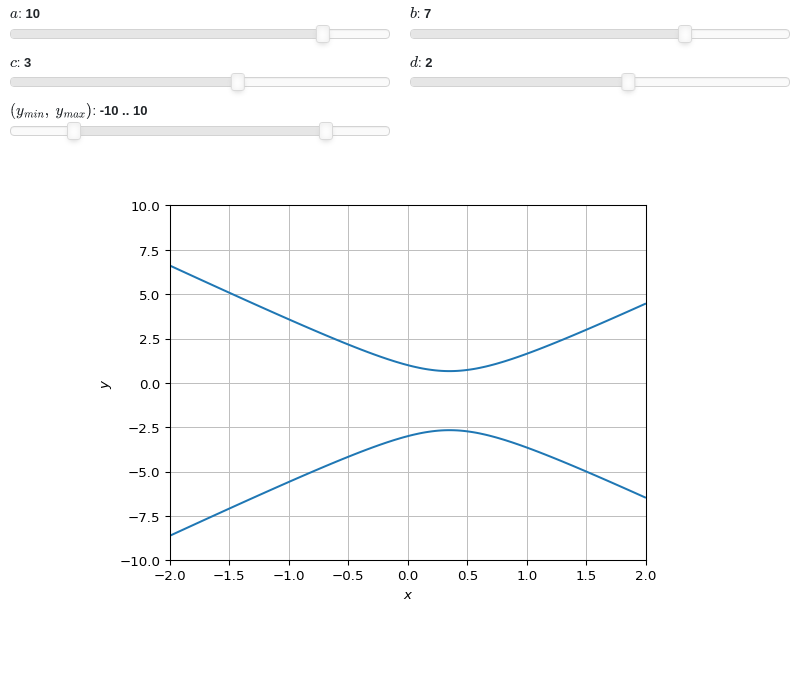
- spb.plot_functions.functions_2d.plot_parametric(*args, **kwargs)[source]
Plots a 2D parametric curve.
Typical usage examples are in the followings:
Plotting a single parametric curve with a range:
plot_parametric(expr_x, expr_y, range)
Plotting multiple parametric curves with the same range:
plot_parametric( (expr_x1, expr_y1), (expr_x2, expr_y2), ..., range)
Plotting multiple curves with different ranges, custom labels and rendering options:
plot_parametric( (expr_x1, expr_y1, range1, label1 [opt], rendering_kw1 [opt]), (expr_x2, expr_y2, range2, label2 [opt], rendering_kw2 [opt]), ...)
Refer to
line_parametric_2d()for a full list of keyword arguments to customize the appearances of lines.Refer to
graphics()for a full list of keyword arguments to customize the appearances of the figure (title, axis labels, …).See also
Examples
>>> from sympy import symbols, cos, sin, pi, floor, log >>> from spb import plot_parametric >>> t, u, v = symbols('t, u, v')
A parametric plot of a single expression (a Hypotrochoid using an equal aspect ratio):
>>> plot_parametric( ... 2 * cos(u) + 5 * cos(2 * u / 3), ... 2 * sin(u) - 5 * sin(2 * u / 3), ... (u, 0, 6 * pi), aspect="equal") Plot object containing: [0]: parametric cartesian line: (5*cos(2*u/3) + 2*cos(u), -5*sin(2*u/3) + 2*sin(u)) for u over (0.0, 18.84955592153876)
(
Source code,png)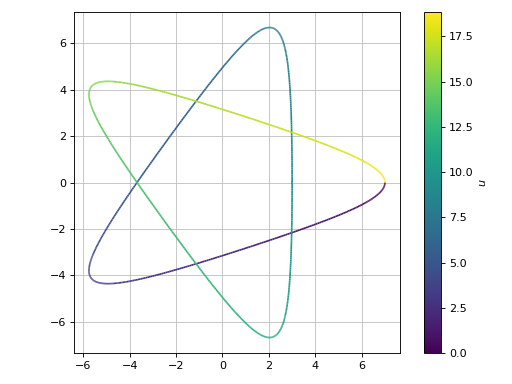
A parametric plot with multiple expressions with the same range with solid line colors:
>>> plot_parametric((2 * cos(t), sin(t)), (cos(t), 2 * sin(t)), ... (t, 0, 2*pi), use_cm=False) Plot object containing: [0]: parametric cartesian line: (2*cos(t), sin(t)) for t over (0.0, 6.283185307179586) [1]: parametric cartesian line: (cos(t), 2*sin(t)) for t over (0.0, 6.283185307179586)
(
Source code,png)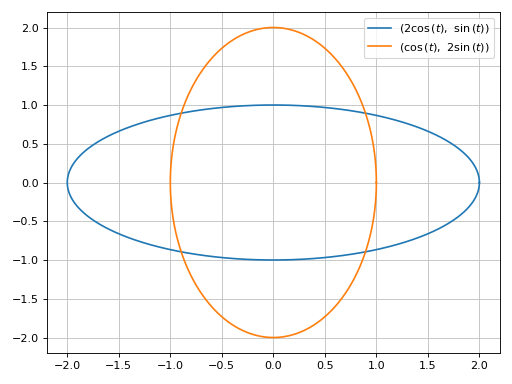
A parametric plot with multiple expressions with different ranges, custom labels, custom rendering options and a transformation function applied to the discretized parameter to convert radians to degrees:
>>> import numpy as np >>> plot_parametric( ... (3 * cos(u), 3 * sin(u), (u, 0, 2 * pi), "u [deg]", {"lw": 3}), ... (3 * cos(2 * v), 5 * sin(4 * v), (v, 0, pi), "v [deg]"), ... aspect="equal", tp=np.rad2deg) Plot object containing: [0]: parametric cartesian line: (3*cos(u), 3*sin(u)) for u over (0.0, 6.283185307179586) [1]: parametric cartesian line: (3*cos(2*v), 5*sin(4*v)) for v over (0.0, 3.141592653589793)
(
Source code,png)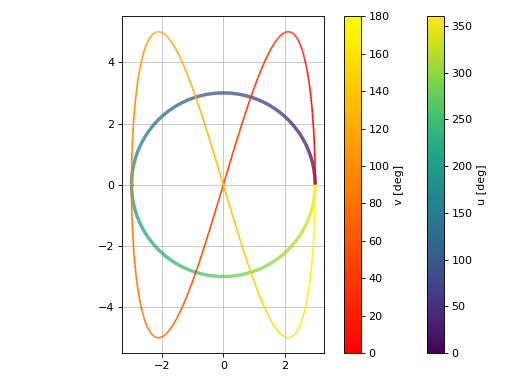
Introducing discontinuities by excluding specified points:
>>> e1 = log(floor(t))*cos(t) >>> e2 = log(floor(t))*sin(t) >>> plot_parametric(e1, e2, (t, 1, 4*pi), ... exclude=list(range(1, 13)), grid=False) Plot object containing: [0]: parametric cartesian line: (log(floor(t))*cos(t), log(floor(t))*sin(t)) for t over (1.0, 12.566370614359172)
(
Source code,png)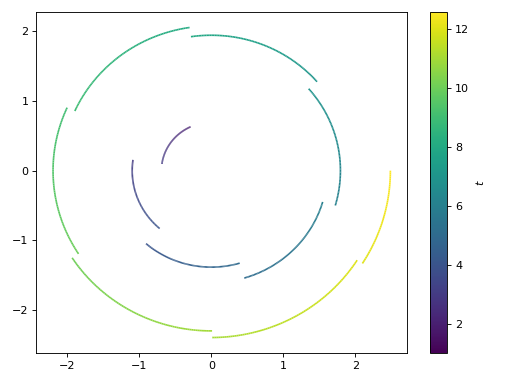
Plotting a numerical function instead of a symbolic expression:
>>> import numpy as np >>> fx = lambda t: np.sin(t) * (np.exp(np.cos(t)) - 2 * np.cos(4 * t) - np.sin(t / 12)**5) >>> fy = lambda t: np.cos(t) * (np.exp(np.cos(t)) - 2 * np.cos(4 * t) - np.sin(t / 12)**5) >>> p = plot_parametric(fx, fy, ("t", 0, 12 * pi), ... title="Butterfly Curve", use_cm=False, n=2000)
(
Source code,png)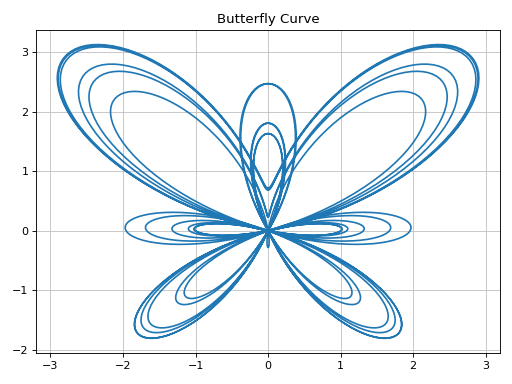
Interactive-widget plot. Refer to the interactive sub-module documentation to learn more about the
paramsdictionary. This plot illustrates:the use of
prange(parametric plotting range).the use of the
paramsdictionary to specify sliders in their basic form: (default, min, max).
from sympy import * from spb import * x, a, s, e = symbols("x a s, e") plot_parametric( cos(a * x), sin(x), prange(x, s*pi, e*pi), params={ a: (0.5, 0, 2), s: (0, 0, 2), e: (2, 0, 2), }, aspect="equal", xlim=(-1.25, 1.25), ylim=(-1.25, 1.25) )
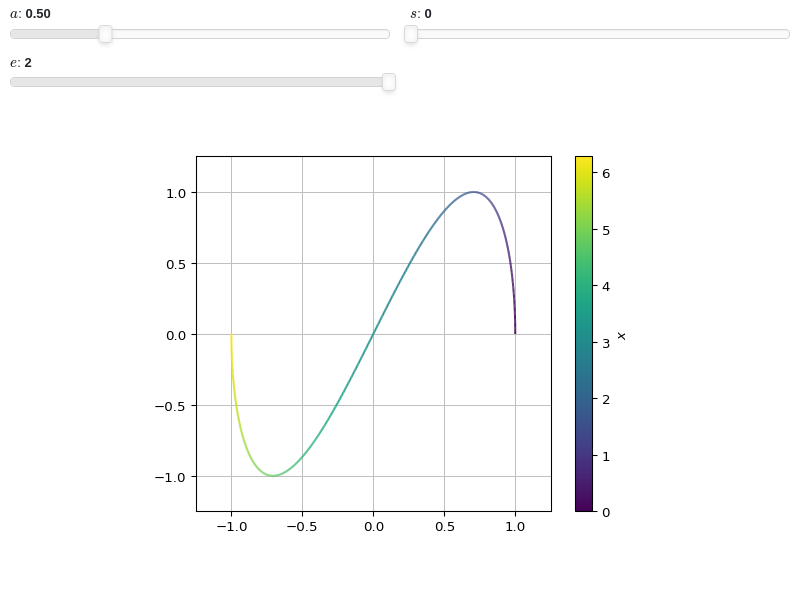
- spb.plot_functions.functions_2d.plot_parametric_region(*args, **kwargs)[source]
Plots a 2D parametric region.
NOTE: this is an experimental plotting function as it only draws lines without fills. The resulting visualization might change when new features will be implemented.
Typical usage examples are in the followings:
Plotting a single parametric curve with a range:
plot_parametric(expr_x, expr_y, range_u, range_v)
Plotting multiple parametric curves with the same range:
plot_parametric((expr_x, expr_y), ..., range_u, range_v)
Plotting multiple parametric curves with different ranges:
plot_parametric((expr_x, expr_y, range_u, range_v), ...)
- Parameters:
- args
- expr_x, expr_yExpr
The expression representing x and y component, respectively, of the parametric function. It can be a:
Symbolic expression representing the function of one variable to be plotted.
Numerical function of one variable, supporting vectorization. In this case the following keyword arguments are not supported:
params.
- range_u, range_v(symbol, min, max)
A 3-tuple denoting the parameter symbols, start and stop. For example, (u, 0, 5), (v, 0, 5). If the ranges are not specified, then they default to (-10, 10).
However, if the arguments are specified as (expr_x, expr_y, range_u, range_v), …, you must specify the ranges for each expressions manually.
- rendering_kwdict, optional
A dictionary of keywords/values which is passed to the backend’s function to customize the appearance of lines. Refer to the plotting library (backend) manual for more informations.
- aspect(float, float) or str, optional
Set the aspect ratio of the plot. The value depends on the backend being used. Read that backend’s documentation to find out the possible values.
- backendPlot, optional
A subclass of
Plot, which will perform the rendering. Default toMatplotlibBackend.- nint, optional
The functions are uniformly sampled at
nnumber of points. Default value to 1000.- n1, n2int, optional
Number of lines to create along each direction. Default to 10. Note: the higher the number, the slower the rendering.
- rkw_u, rkw_vdict
A dictionary of keywords/values which is passed to the backend’s function to customize the appearance of lines along the u and v directions, respectively. These overrides
rendering_kwif provided. Refer to the plotting library (backend) manual for more informations.- showbool, optional
The default value is set to
True. Set show toFalseand the function will not display the plot. The returned instance of thePlotclass can then be used to save or display the plot by calling thesave()andshow()methods respectively.- size(float, float), optional
A tuple in the form (width, height) to specify the size of the overall figure. The default value is set to
None, meaning the size will be set by the backend.- titlestr, optional
Title of the plot. It is set to the latex representation of the expression, if the plot has only one expression.
- use_latexboolean, optional
Turn on/off the rendering of latex labels. If the backend doesn’t support latex, it will render the string representations instead.
- xlabel, ylabelstr, optional
Label for the x-axis or y-axis, respectively.
- xscale, yscale‘linear’ or ‘log’, optional
Sets the scaling of the x-axis or y-axis, respectively. Default to
'linear'.- xlim, ylim(float, float), optional
Denotes the x-axis or y-axis limits,
(min, max), visible in the chart.
Examples
>>> from sympy import symbols, cos, sin, pi, I, re, im, latex >>> from spb import plot_parametric_region
Plot a slice of a ring, applying the same style to all lines:
>>> r, theta = symbols("r theta") >>> p = plot_parametric_region(r * cos(theta), r * sin(theta), ... (r, 1, 2), (theta, 0, 2*pi/3), ... {"color": "k", "linewidth": 0.75}, ... n1=5, n2=15, aspect="equal")
(
Source code,png)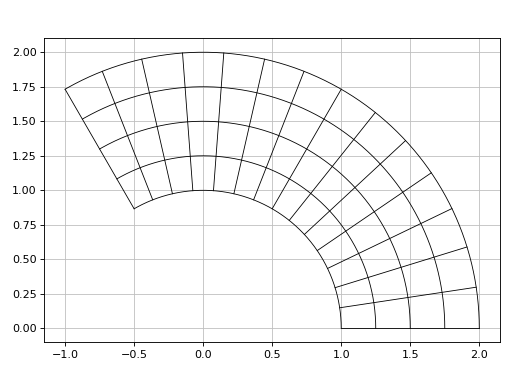
Complex mapping, applying to different line styles:
>>> x, y, z = symbols("x y z") >>> f = 1 / z**2 >>> f_cart = f.subs(z, x + I * y) >>> r, i = re(f_cart), im(f_cart) >>> n1, n2 = 30, 30 >>> p = plot_parametric_region(r, i, (x, -2, 2), (y, -2, 2), ... rkw_u={"color": "r", "linewidth": 0.75}, ... rkw_v={"color": "b", "linewidth": 0.75}, ... n1=20, n2=20, aspect="equal", xlim=(-2, 2), ylim=(-2, 2), ... xlabel="Re", ylabel="Im", title="$f(z)=%s$" % latex(f))
(
Source code,png)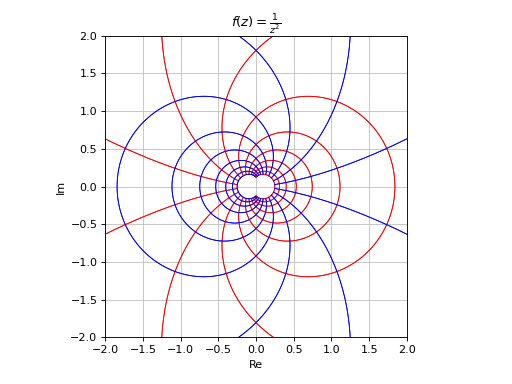
- spb.plot_functions.functions_2d.plot_contour(*args, **kwargs)[source]
Draws contour plot of a function of two variables.
This function signature is almost identical to
plot3d(): refer to its documentation for a full list of available argument and keyword arguments.Refer to
contour()for a full list of keyword arguments to customize the appearances of contours.Refer to
graphics()for a full list of keyword arguments to customize the appearances of the figure (title, axis labels, …).- Parameters:
- clabelsbool, optional
Visualize labels of contour lines. Only works when
is_filled=False. Default to True. Note that some backend might not implement this feature.- is_filledbool, optional
Choose between filled contours or line contours. Default to True (filled contours).
- polar_axisboolean, optional
If True, attempt to create a plot with polar axis. Default to False, which creates a plot with cartesian axis.
See also
Examples
>>> from sympy import symbols, cos, exp, sin, pi, Eq, Add >>> from spb import plot_contour >>> x, y = symbols('x, y')
Filled contours of a function of two variables.
>>> plot_contour(cos((x**2 + y**2)) * exp(-(x**2 + y**2) / 10), ... (x, -5, 5), (y, -5, 5)) Plot object containing: [0]: contour: exp(-x**2/10 - y**2/10)*cos(x**2 + y**2) for x over (-5.0, 5.0) and y over (-5.0, 5.0)
(
Source code,png)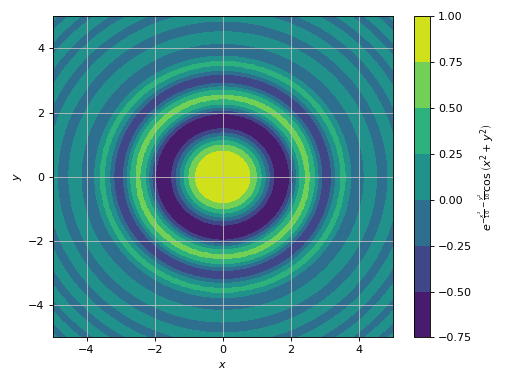
Line contours of a function of two variables.
>>> expr = 5 * (cos(x) - 0.2 * sin(y))**2 + 5 * (-0.2 * cos(x) + sin(y))**2 >>> plot_contour(expr, (x, 0, 2 * pi), (y, 0, 2 * pi), is_filled=False) Plot object containing: [0]: contour: 5*(-0.2*sin(y) + cos(x))**2 + 5*(sin(y) - 0.2*cos(x))**2 for x over (0.0, 6.283185307179586) and y over (0.0, 6.283185307179586)
(
Source code,png)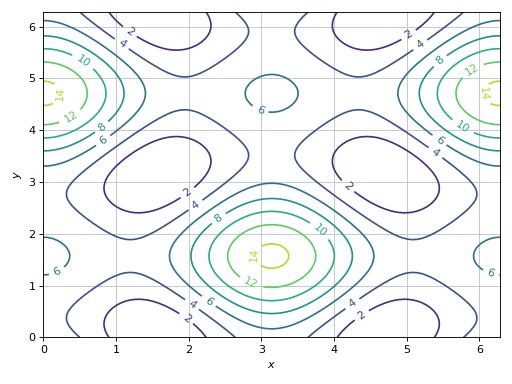
Combining together filled and line contours. Use a custom label on the colorbar of the filled contour.
>>> expr = 5 * (cos(x) - 0.2 * sin(y))**2 + 5 * (-0.2 * cos(x) + sin(y))**2 >>> p1 = plot_contour(expr, (x, 0, 2 * pi), (y, 0, 2 * pi), "z", ... {"cmap": "coolwarm"}, show=False, grid=False) >>> p2 = plot_contour(expr, (x, 0, 2 * pi), (y, 0, 2 * pi), ... {"colors": "k", "cmap": None, "linewidths": 0.75}, ... show=False, is_filled=False) >>> (p1 + p2).show()
(
Source code,png)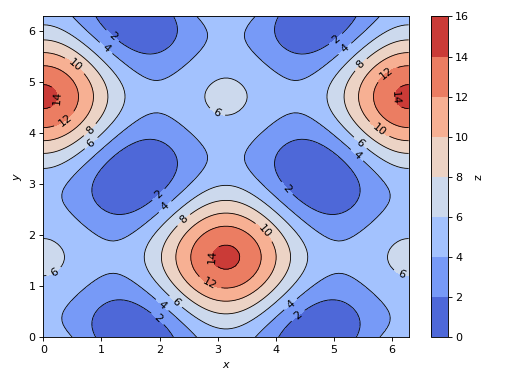
Visually inspect the solutions of a system of 2 non-linear equations. The intersections between the contour lines represent the solutions.
>>> eq1 = Eq((cos(x) - sin(y) / 2)**2 + 3 * (-sin(x) + cos(y) / 2)**2, 2) >>> eq2 = Eq((cos(x) - 2 * sin(y))**2 - (sin(x) + 2 * cos(y))**2, 3) >>> plot_contour(eq1.rewrite(Add), eq2.rewrite(Add), {"levels": [0]}, ... (x, 0, 2 * pi), (y, 0, 2 * pi), is_filled=False, clabels=False) Plot object containing: [0]: contour: 3*(-sin(x) + cos(y)/2)**2 + (-sin(y)/2 + cos(x))**2 - 2 for x over (0.0, 6.283185307179586) and y over (0.0, 6.283185307179586) [1]: contour: -(sin(x) + 2*cos(y))**2 + (-2*sin(y) + cos(x))**2 - 3 for x over (0.0, 6.283185307179586) and y over (0.0, 6.283185307179586)
(
Source code,png)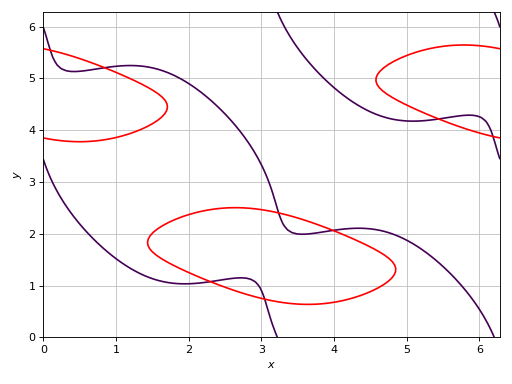
Contour plot with polar axis:
>>> r, theta = symbols("r, theta") >>> plot_contour(sin(2 * r) * cos(theta), (theta, 0, 2*pi), (r, 0, 7), ... {"levels": 100}, polar_axis=True, aspect="equal") Plot object containing: [0]: contour: sin(2*r)*cos(theta) for theta over (0.0, 6.283185307179586) and r over (0.0, 7.0)
(
Source code,png)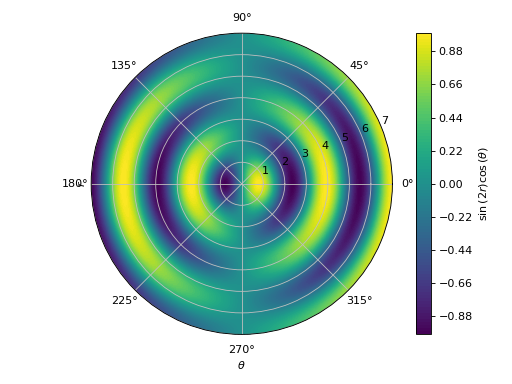
Interactive-widget plot. Refer to the interactive sub-module documentation to learn more about the
paramsdictionary. This plot illustrates:the use of
prange(parametric plotting range).the use of the
paramsdictionary to specify sliders in their basic form: (default, min, max).the use of
panel.widgets.slider.RangeSlider, which is a 2-values widget.
from sympy import * from spb import * import panel as pn x, y, a, b = symbols("x y a b") x_min, x_max, y_min, y_max = symbols("x_min x_max y_min y_max") expr = (cos(x) + a * sin(x) * sin(y) - b * sin(x) * cos(y))**2 plot_contour( expr, prange(x, x_min*pi, x_max*pi), prange(y, y_min*pi, y_max*pi), params={ a: (1, 0, 2), b: (1, 0, 2), (x_min, x_max): pn.widgets.RangeSlider( value=(-1, 1), start=-3, end=3, step=0.1), (y_min, y_max): pn.widgets.RangeSlider( value=(-1, 1), start=-3, end=3, step=0.1), }, grid=False)
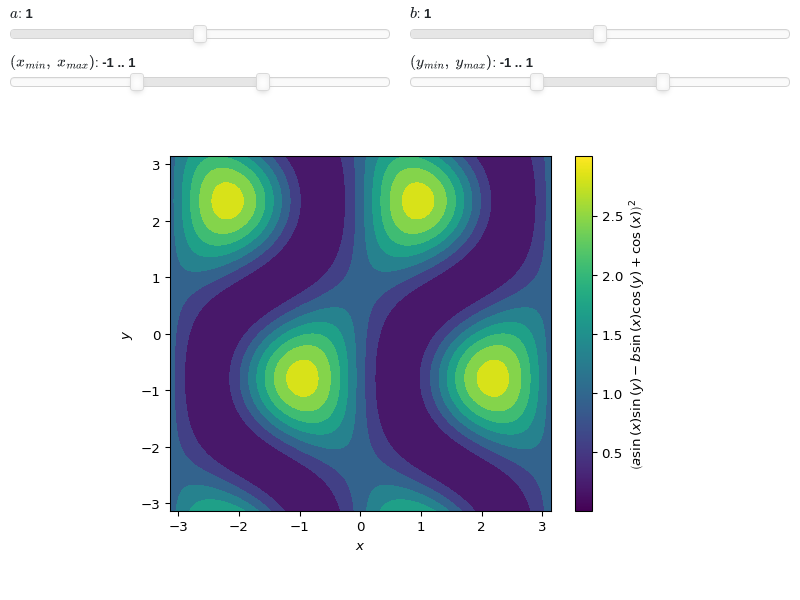
- spb.plot_functions.functions_2d.plot_polar(*args, **kwargs)[source]
The following function creates a 2D polar plot.
By default, it uses an equal aspect ratio and doesn’t apply a colormap.
Typical usage examples are in the followings:
Plotting a single polar curve with a range:
plot_polar(expr, range)
Plotting multiple polar curves with the same range:
plot_polar(expr1, expr2, ..., range)
Plotting multiple curves with different ranges, custom labels and rendering options:
plot_polar( (expr1, range1, label1 [opt], rendering_kw1 [opt]), (expr2, range2, label2 [opt], rendering_kw2 [opt]), ..., **kwargs)
This function is going to execute
line_parametric_2d(). Refer to its documentation for a full list of keyword arguments to customize the appearances of lines.Refer to
graphics()for a full list of keyword arguments to customize the appearances of the figure (title, axis labels, …).- Parameters:
- polar_axisboolean, optional
If True, attempt to create a plot with polar axis. Default to False, which creates a plot with cartesian axis.
See also
Examples
>>> from sympy import symbols, sin, cos, exp, pi >>> from spb import plot_polar >>> theta = symbols('theta')
Plot with cartesian axis:
>>> plot_polar(3 * sin(2 * theta), (theta, 0, 2*pi)) Plot object containing: [0]: parametric cartesian line: (3*sin(2*theta)*cos(theta), 3*sin(theta)*sin(2*theta)) for theta over (0.0, 6.283185307179586)
(
Source code,png)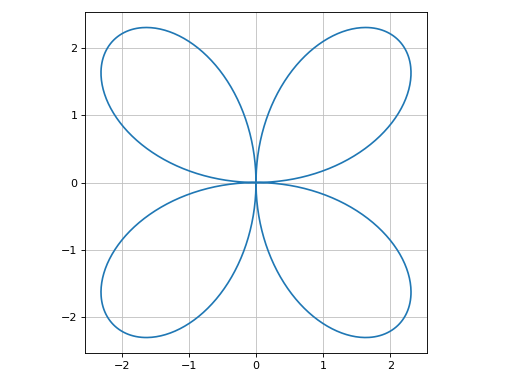
Plot with polar axis:
>>> plot_polar( ... exp(sin(theta)) - 2 * cos(4 * theta), (theta, 0, 2 * pi), ... polar_axis=True) Plot object containing: [0]: parametric cartesian line: ((exp(sin(theta)) - 2*cos(4*theta))*cos(theta), (exp(sin(theta)) - 2*cos(4*theta))*sin(theta)) for theta over (0.0, 6.283185307179586)
(
Source code,png)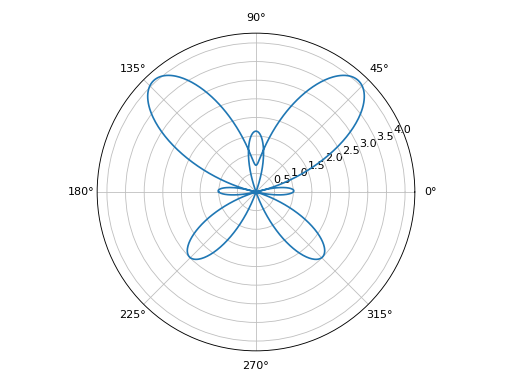
Interactive-widget plot of Guilloché Pattern. Refer to the interactive sub-module documentation to learn more about the
paramsdictionary. This plot illustrates:the use of
prange(parametric plotting range).the use of the
paramsdictionary to specify the widgets to be created by Holoviz’s Panel.
from sympy import * from spb import * import panel as pn a, b, c, d, e, f, theta, tp = symbols("a:f theta tp") def func(n): t1 = (c + sin(a * theta + d)) t2 = ((b + sin(b * theta + e)) - (c + sin(a * theta + d))) t3 = (f + sin(a * theta + n / pi)) return t1 + t2 * t3 / 2 exprs = [func(n) for n in range(20)] plot_polar( *exprs, prange(theta, 0, tp*pi), {"line_color": "black", "line_width": 0.5}, params={ a: pn.widgets.IntInput(value=6, name="a"), b: pn.widgets.IntInput(value=12, name="b"), c: pn.widgets.IntInput(value=18, name="c"), d: (4.7, 0, 2*pi), e: (1.8, 0, 2*pi), f: (3, 0, 5), tp: (2, 0, 2) }, layout = "sbl", ncols = 1, title="Guilloché Pattern Explorer", backend=BB, legend=False, servable=True, imodule="panel" )
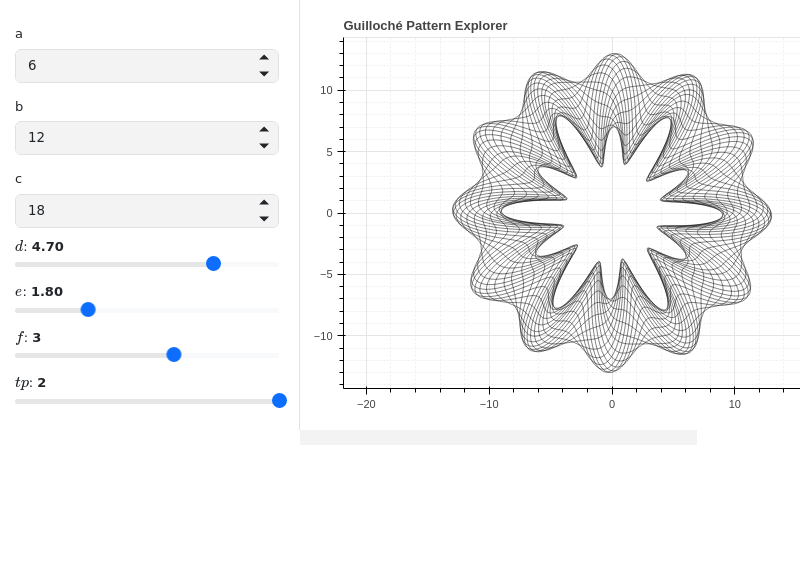
- spb.plot_functions.functions_2d.plot_geometry(*args, **kwargs)[source]
Plot entities from the sympy.geometry module.
Typical usage examples are in the following:
Plotting a single geometric entity:
plot_geometry(geom, label [opt], rendering_kw [opt])
Plotting multiple geometric entities:
plot_geometry(geom1, geom2, ...)
Plotting multiple geometric entities, setting custom labels and rendering options:
plot_geometry( (geom1, label1 [opt], rendering_kw1 [opt]), (geom2, label2 [opt], rendering_kw2 [opt]), **kwargs)
Refer to
geometry()for a full list of keyword arguments to customize the appearances of lines and regions.Refer to
graphics()for a full list of keyword arguments to customize the appearances of the figure (title, axis labels, …).See also
Examples
>>> from sympy import (symbols, Circle, Ellipse, Polygon, ... Curve, Segment, Point2D, Point3D, Line3D, Plane, ... Rational, pi, Point, cos, sin) >>> from spb import plot_geometry >>> x, y, z = symbols('x, y, z')
Plot a single geometry, customizing its color:
>>> plot_geometry( ... Ellipse(Point(-3, 2), hradius=3, eccentricity=Rational(4, 5)), ... {"color": "tab:orange"}, grid=False) Plot object containing: [0]: geometry entity: Ellipse(Point2D(-3, 2), 3, 9/5)
(
Source code,png)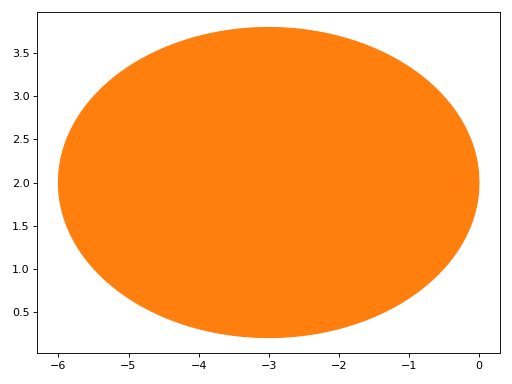
Plot several numeric geometric entitiesy. By default, circles, ellipses and polygons are going to be filled. Plotting Curve objects is the same as plot_parametric.
>>> plot_geometry( ... Circle(Point(0, 0), 5), ... Ellipse(Point(-3, 2), hradius=3, eccentricity=Rational(4, 5)), ... Polygon((4, 0), 4, n=5), ... Curve((cos(x), sin(x)), (x, 0, 2 * pi)), ... Segment((-4, -6), (6, 6)), ... Point2D(0, 0)) Plot object containing: [0]: geometry entity: Circle(Point2D(0, 0), 5) [1]: geometry entity: Ellipse(Point2D(-3, 2), 3, 9/5) [2]: geometry entity: RegularPolygon(Point2D(4, 0), 4, 5, 0) [3]: parametric cartesian line: (cos(x), sin(x)) for x over (0.0, 6.283185307179586) [4]: geometry entity: Segment2D(Point2D(-4, -6), Point2D(6, 6)) [5]: geometry entity: Point2D(0, 0)
(
Source code,png)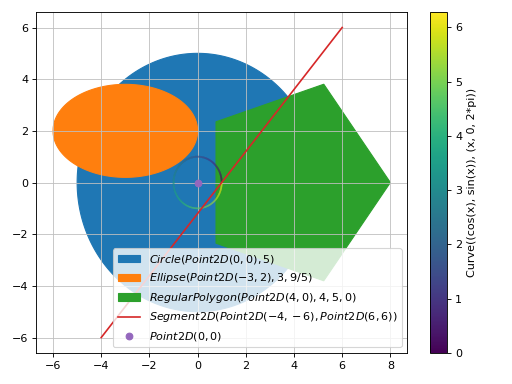
Plot several numeric geometric entities defined by numbers only, turn off fill. Every entity is represented as a line.
>>> plot_geometry( ... Circle(Point(0, 0), 5), ... Ellipse(Point(-3, 2), hradius=3, eccentricity=Rational(4, 5)), ... Polygon((4, 0), 4, n=5), ... Curve((cos(x), sin(x)), (x, 0, 2 * pi)), ... Segment((-4, -6), (6, 6)), ... Point2D(0, 0), is_filled=False) Plot object containing: [0]: geometry entity: Circle(Point2D(0, 0), 5) [1]: geometry entity: Ellipse(Point2D(-3, 2), 3, 9/5) [2]: geometry entity: RegularPolygon(Point2D(4, 0), 4, 5, 0) [3]: parametric cartesian line: (cos(x), sin(x)) for x over (0.0, 6.283185307179586) [4]: geometry entity: Segment2D(Point2D(-4, -6), Point2D(6, 6)) [5]: geometry entity: Point2D(0, 0)
(
Source code,png)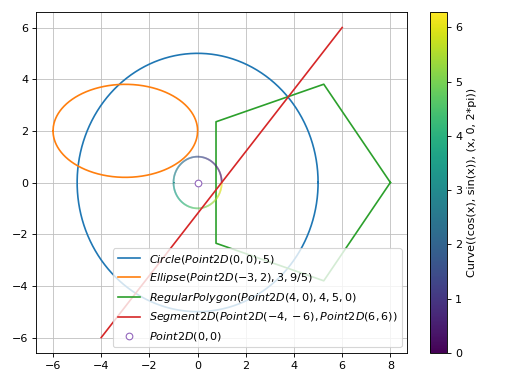
Plot several symbolic geometric entities. We need to pass in the params dictionary, which will be used to substitute symbols before numerical evaluation. Note: here we also set custom labels:
>>> a, b, c, d = symbols("a, b, c, d") >>> plot_geometry( ... (Polygon((a, b), c, n=d), "triangle"), ... (Polygon((a + 2, b + 3), c, n=d + 1), "square"), ... params = {a: 0, b: 1, c: 2, d: 3}) Plot object containing: [0]: geometry entity: RegularPolygon(Point2D(0, 1), 2, 3, 0) [1]: geometry entity: RegularPolygon(Point2D(2, 4), 2, 4, 0)
(
Source code,png)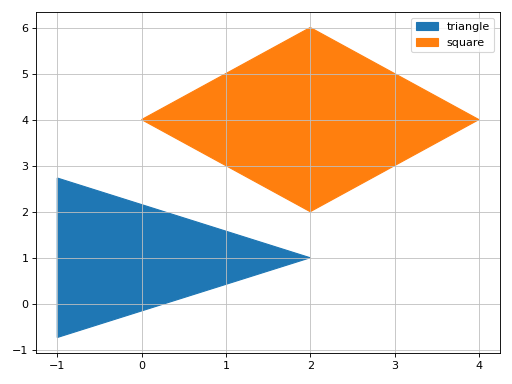
Plot 3D geometric entities. Note: when plotting a Plane, we must always provide the x/y/z ranges:
>>> plot_geometry( ... (Point3D(5, 5, 5), "center"), ... (Line3D(Point3D(-2, -3, -4), Point3D(2, 3, 4)), "line"), ... (Plane((0, 0, 0), (1, 1, 1)), ... (x, -5, 5), (y, -4, 4), (z, -10, 10))) Plot object containing: [0]: geometry entity: Point3D(5, 5, 5) [1]: geometry entity: Line3D(Point3D(-2, -3, -4), Point3D(2, 3, 4)) [2]: plane series: Plane(Point3D(0, 0, 0), (1, 1, 1)) over (x, -5, 5), (y, -4, 4), (z, -10, 10)
(
Source code,png)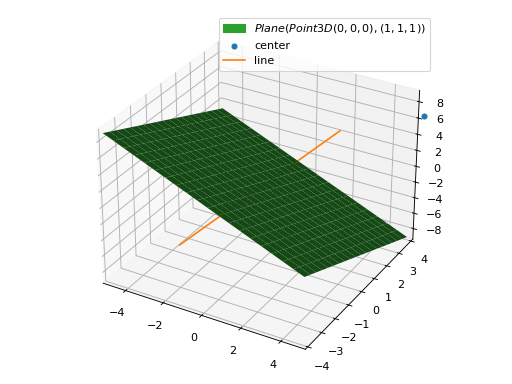
Interactive-widget plot. Refer to the interactive sub-module documentation to learn more about the
paramsdictionary.from sympy import * from spb import * import panel as pn a, b, c, d = symbols("a, b, c, d") plot_geometry( (Polygon((a, b), c, n=d), "a"), (Polygon((a + 2, b + 3), c, n=d + 1), "b"), params = { a: (0, -1, 1), b: (1, -1, 1), c: (2, 1, 2), d: pn.widgets.IntInput(value=3, start=3, end=8, name="n") }, aspect="equal", is_filled=False, xlim=(-2.5, 5.5), ylim=(-3, 6.5), imodule="panel")
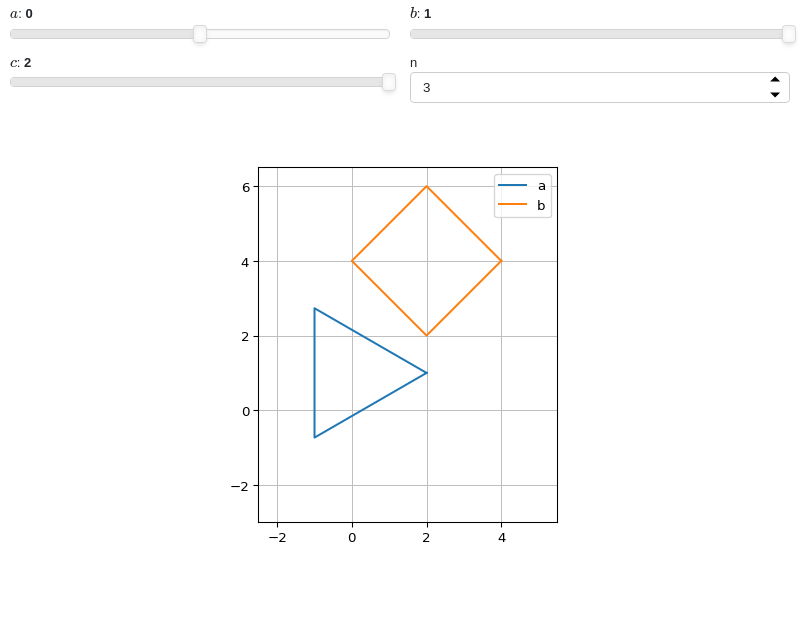
- spb.plot_functions.functions_2d.plot_list(*args, **kwargs)[source]
Plots lists of coordinates (ie, lists of numbers).
Typical usage examples are in the followings:
Plotting coordinates of a single function:
plot_list(x, y, **kwargs)
Plotting coordinates of multiple functions, adding custom labels and rendering options:
plot_list( (x1, y1, label1 [opt], rendering_kw1 [opt]), (x2, y2, label2 [opt], rendering_kw2 [opt]), ..., **kwargs)
Refer to
list_2d()for a full list of keyword arguments to customize the appearances of lines.Refer to
graphics()for a full list of keyword arguments to customize the appearances of the figure (title, axis labels, …).See also
plot,plot_implicit,plot_polar,plot_parametric,plot_contourplot_geometry,plot_piecewise,plot3d_list
Examples
>>> from sympy import symbols, sin, cos >>> from spb import plot_list >>> x = symbols('x')
Plot the coordinates of a single function:
>>> xx = [t / 100 * 6 - 3 for t in list(range(101))] >>> yy = [cos(x).evalf(subs={x: t}) for t in xx] >>> plot_list(xx, yy) Plot object containing: [0]: 2D list plot
(
Source code,png)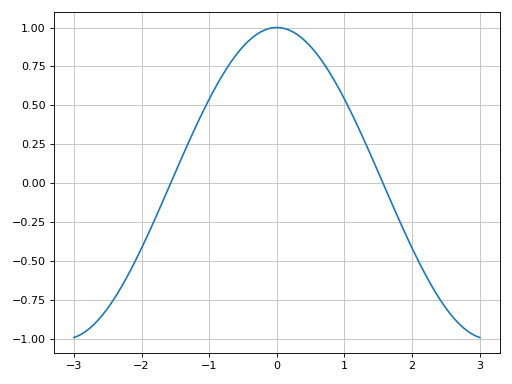
Plot individual points with custom labels:
>>> plot_list( ... ([0], [0], "A"), ([1], [1], "B"), ([2], [0], "C"), ... scatter=True, is_filled=True) Plot object containing: [0]: 2D list plot [1]: 2D list plot [2]: 2D list plot
(
Source code,png)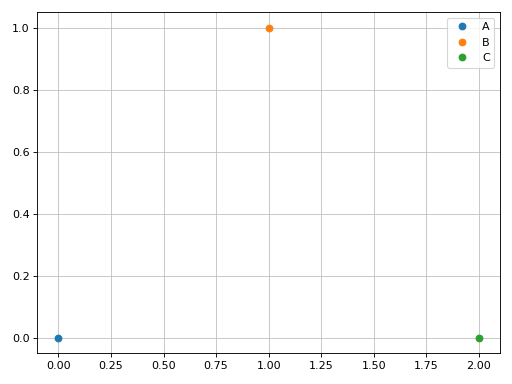
Scatter plot of the coordinates of multiple functions, with custom rendering keywords:
>>> xx = [t / 70 * 6 - 3 for t in list(range(71))] >>> yy1 = [cos(x).evalf(subs={x: t}) for t in xx] >>> yy2 = [sin(x).evalf(subs={x: t}) for t in xx] >>> plot_list( ... (xx, yy1, "cos"), ... (xx, yy2, "sin", {"marker": "*", "markerfacecolor": None}), ... scatter=True) Plot object containing: [0]: 2D list plot [1]: 2D list plot
(
Source code,png)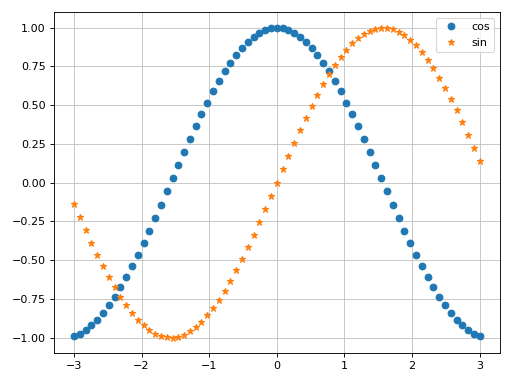
Interactive-widget plot. Refer to the interactive sub-module documentation to learn more about the
paramsdictionary.from sympy import * from spb import * x, t = symbols("x, t") params = {t: (0, 0, 2*pi)} # plot trajectories p1 = plot_parametric( (cos(x), sin(x), (x, 0, 2*pi), {"linestyle": ":"}), (cos(2 * x) / 2, sin(2 * x) / 2, (x, 0, pi), {"linestyle": ":"}), use_cm=False, aspect="equal", show=False, params=params, imodule="panel") # plot points p2 = plot_list( ([cos(t)], [sin(t)], "A"), ([cos(2 * t) / 2], [sin(2 * t) / 2], "B"), rendering_kw={"marker": "s", "markerfacecolor": None}, params=params, scatter=True, show=False) (p1 + p2).show()
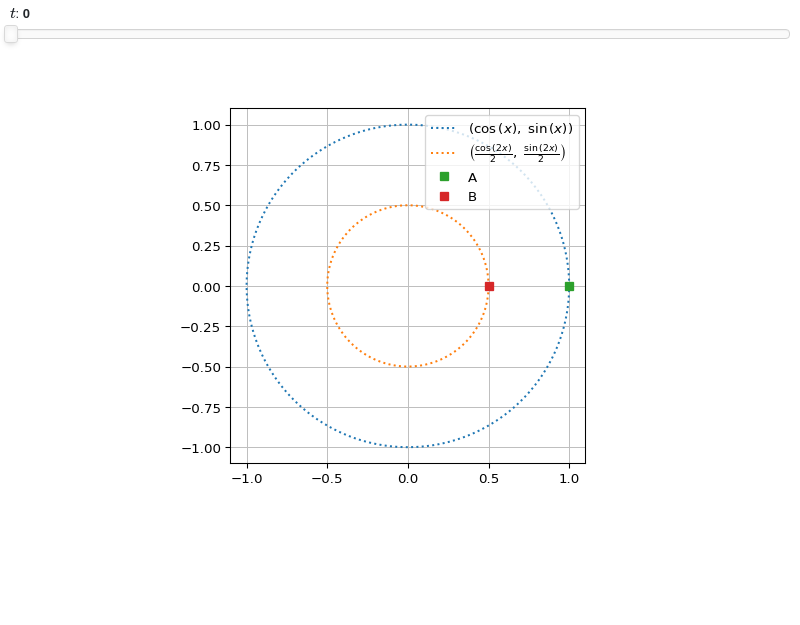
- spb.plot_functions.functions_2d.plot_piecewise(*args, **kwargs)[source]
Plots univariate piecewise functions.
Typical usage examples are in the followings:
Plotting a single expression with the default range (-10, 10):
plot_piecewise(expr, **kwargs)
Plotting multiple expressions with a single range:
plot_piecewise(expr1, expr2, ..., range, **kwargs)
Plotting multiple expressions with multiple ranges, custom labels and rendering options:
plot_piecewise( (expr1, range1, label1 [opt], rendering_kw1 [opt]), (expr2, range2, label2 [opt], rendering_kw2 [opt]), ..., **kwargs)`
Refer to
line()for a full list of keyword arguments to customize the appearances of lines.Refer to
graphics()for a full list of keyword arguments to customize the appearances of the figure (title, axis labels, …).- Parameters:
- dotsboolean
Wheter to show circular markers at the endpoints. Default to True.
See also
Examples
>>> from sympy import symbols, sin, cos, pi, Heaviside, Piecewise, Eq >>> from spb import plot_piecewise >>> x = symbols('x')
Single Plot
>>> f = Piecewise((x**2, x < 2), (5, Eq(x, 2)), (10 - x, True)) >>> plot_piecewise(f, (x, -2, 5)) Plot object containing: [0]: cartesian line: x**2 for x over (-2.0, 1.999999) [1]: 2D list plot [2]: cartesian line: 10 - x for x over (2.000001, 5.0) [3]: 2D list plot [4]: 2D list plot
(
Source code,png)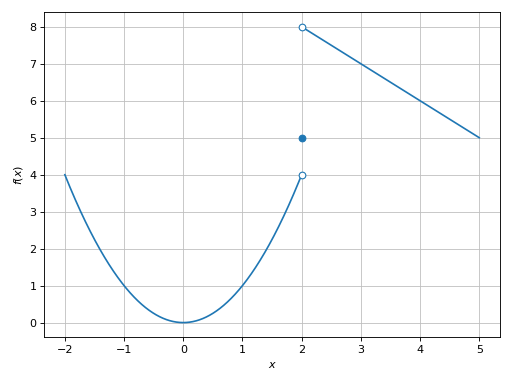
Single plot without dots (circular markers):
>>> plot_piecewise(Heaviside(x, 0).rewrite(Piecewise), ... (x, -10, 10), dots=False) Plot object containing: [0]: cartesian line: 0 for x over (-10.0, 0.0) [1]: cartesian line: 1 for x over (1e-06, 10.0)
(
Source code,png)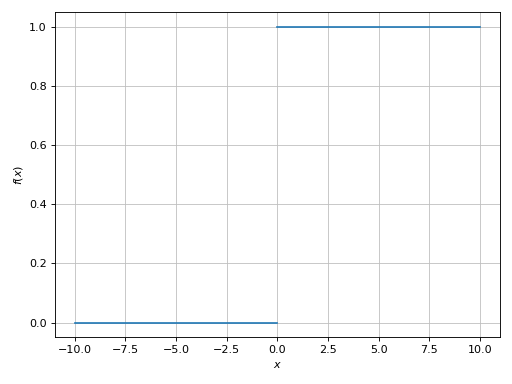
Plot multiple expressions in which the second piecewise expression has a dotted line style. Use the
labelkeyword argument to set the appropriate entries for the legend:>>> plot_piecewise( ... (Heaviside(x, 0).rewrite(Piecewise), (x, -10, 10)), ... (Piecewise( ... (sin(x), x < -5), ... (cos(x), x > 5), ... (1 / x, True)), (x, -8, 8), {"linestyle": ":"}), ... ylim=(-2, 2), detect_poles=True, legend=True, label=["A", "B"]) Plot object containing: [0]: cartesian line: 0 for x over (-10.0, 0.0) [1]: cartesian line: 1 for x over (1e-06, 10.0) [2]: 2D list plot [3]: 2D list plot [4]: cartesian line: sin(x) for x over (-8.0, -5.000001) [5]: 2D list plot [6]: cartesian line: cos(x) for x over (5.000001, 8.0) [7]: 2D list plot [8]: cartesian line: 1/x for x over (-5.0, 5.0) [9]: 2D list plot [10]: 2D list plot
(
Source code,png)